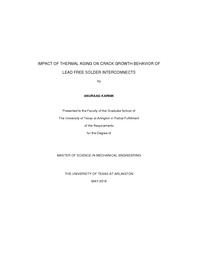
ATTENTION: The works hosted here are being migrated to a new repository that will consolidate resources, improve discoverability, and better show UTA's research impact on the global community. We will update authors as the migration progresses. Please see MavMatrix for more information.
Show simple item record
| dc.contributor.advisor | Agonafer, Dereje | |
| dc.creator | Karnik, Anuraag Girish | |
| dc.date.accessioned | 2018-06-05T19:06:21Z | |
| dc.date.available | 2018-06-05T19:06:21Z | |
| dc.date.created | 2018-05 | |
| dc.date.issued | 2018-05-24 | |
| dc.date.submitted | May 2018 | |
| dc.identifier.uri | | |
| dc.identifier.uri | http://hdl.handle.net/10106/27480 | |
| dc.description.abstract | Reliability assessment helps in better performance of electronic packages. This also helps electronic device manufacturing company as well as the users to evaluate the life of any device. The microstructure, mechanical response, and failure behavior of Pb-free solder joints in electronic assemblies are constantly evolving when exposed to isothermal aging and/or thermal cycling environments. Due to reflow process or exposure to harsh environment conditions, packages are subject to fatigue loads which can accelerate crack growth in the solder interconnects. But, some material after aging get hardened and decrease in plastic deformation capacity. This effect sometimes leads to better crack resistance due to surface roughness. A direct and detrimental effect on packaging reliability is observed during elevated temperature thermal aging for Pb-free BGA packages. In past studies, researchers have revealed that pb-free material undergo significant change in mechanical properties and which in turn influences stress-strain behavior of solder. The stresses developed due to CTE mismatch of different materials used in package causes failure of the solder interconnects.
In this thesis, an attempt has been made to study damage progression of cracks that occurs in solder interconnects and its relation to Stress Intensity Factor (SIF) for different thermal aging and thermal cyclin profiles. Experimental test was performed for different temperatures and time on the solder and PCB. Dynamic mechanical analysis (DMA) and thermomechanical analysis (TMA) are used for characterizing thermomechanical properties of the solder and PCB material. A finite element model and theory associated with experimental observations has been employed for understanding fracture of solder interconnects due to aging of solder and PCB. Also, FEA has been made use of to calculate all stress components and its variations through time and along the area of interest i.e. circumferential area of solder ball interconnects, up to 25µm along the length of the interconnects. Failure progression is analyzed by creating a relation between crack dimensions, stress developed and load. The analysis leads to better understanding of crack propagation, evaluating relation between thermal load, stress intensity factor, crack dimension and reduces experimenting time and cost. | |
| dc.format.mimetype | application/pdf | |
| dc.language.iso | en_US | |
| dc.subject | Thermal aging | |
| dc.subject | Thermal cycling | |
| dc.subject | Fracture | |
| dc.subject | J-integral | |
| dc.subject | Stress intensity factor | |
| dc.title | IMPACT OF THERMAL AGING ON CRACK GROWTH BEHAVIOR OF LEAD FREE SOLDER INTERCONNECTS | |
| dc.type | Thesis | |
| dc.degree.department | Mechanical and Aerospace Engineering | |
| dc.degree.name | Master of Science in Mechanical Engineering | |
| dc.date.updated | 2018-06-05T19:06:52Z | |
| thesis.degree.department | Mechanical and Aerospace Engineering | |
| thesis.degree.grantor | The University of Texas at Arlington | |
| thesis.degree.level | Masters | |
| thesis.degree.name | Master of Science in Mechanical Engineering | |
| dc.type.material | text | |
Files in this item
- Name:
- KARNIK-THESIS-2018.pdf
- Size:
- 1.276Mb
- Format:
- PDF
This item appears in the following Collection(s)
Show simple item record


